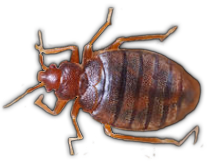
Bedbugs were very common in the 1940’s and 1950’s but the wide spread use of long- term residual insecticides virtually eliminated them.
Recently however, bedbugs have undergone a dramatic resurgence. They are great travelers and are readily transported via luggage, clothing, bedding, stuffed animals and furniture. They are now found in homes, apartments, hotels, motels, dormitories, shelters and modes of transportation. Reliable Pest Control’s environmental services cover the entire Central and Southwestern regions of Ontario. This includes Oshawa, Whitby, Pickering, Scarborough, Toronto, North York, Barrie, Caledon, Alliston, Brampton, Guelph, Burlington, Oakville, Mississauga, and Newmarket, Alliston and Brampton.
Bedbugs are small (1/8 inch), brownish, flattened insects that feed solely on blood. The immature stages (nymphs) resemble the adults but are smaller. Female bedbugs lay thin eggs in secluded areas depositing up to 5 a day, and 500 during a lifetime. The eggs hatch; the nymphs (young) emerge and actively seek a blood meal, preferably a human. If no human is available they will feed on other warm-blooded animals, including pets. Adult bedbugs can survive for 6-7 months without a blood meal and have been known to live in abandoned houses for one year.
These creatures are small but can create a lot of trouble. Bedbugs, if stuck on to the human body continuously for weeks, may cause some serious allergies and rashes on the body. In that case a physician should be immediately contacted to reduce the effect of the allergy caused by the bedbugs. It is always advisable to the residents to not to use the insecticides on the mattresses or at any other thing or place to kill bed bugs that is just in direct contact with the person. For any assistance regarding the bedbugs Toronto services please feel free to discuss with us.
Questions and Answers
Q. Where do bedbugs come from?
A. Bedbugs can’t fly so they either crawl or are carried from place to place. Bedbugs or their eggs can hitch hike in a traveler’s suitcase or clothing. Business people and vacationers routinely travelling to countries where bedbugs are common end up bringing either adults or bedbug eggs back with them.
Q. What do bedbugs do?
A. A bedbug feeds about once a week, usually for several minutes. It most often feeds on a sleeper’s exposed skin. The bite is nearly painless and is not felt by most people. Some people have no reaction afterwards, but most people develop a hard bump with a whitish centre, which can itch for days. Bedbugs can survive for several months between blood meals if there is no person or animal for them to feed on.
Q. Can bedbugs spread diseases in humans?
A. Although bedbugs suck blood like other human parasites, there has been no evidence that they spread diseases.
Q. Where do the bedbugs hide?
A. Bedbugs can live in almost any crack or crevice. They usually stay close to their food source (blood) but can spread rapidly to other areas of the house. The most common place to find them is in the bed. Bedbugs often hide within seams, tufts and crevices of the mattress, box spring, bed frame, headboard, picture frames, dresser drawers and behind wallpaper.
Q. How do I know I have bedbugs and not fleas?
A. Rarely are fleas found in secluded spots like cracks and crevices around the bedroom. Bedbugs can be found and seen in and around mattress seams, tufts and box springs. Look for light brown flat insects about 1/4 to 3/8 to an inch in size. Bedbugs also leave behind molted case skins and dried excrement spots on the mattress sheets and seams. Fleas do not do this. A severe bedbug population does emit a very sweet odour similar to strawberries.
Q. Can I do anything to prevent a bedbug infestation?
A. Refrain from bringing into your home used mattresses and furniture. Thoroughly inspect luggage after returning from a trip to a country where bedbugs are common.
Contact our 24/7 Hotline at 1-833-831-2727 to get rid of Bed Bugs!
Preparation Guidelines for Bedbug Treatment
It is very difficult to eliminate a bedbug infestation with the insecticides that are available today. A minimum of two treatments are needed, two weeks apart.
• Strip the bed(s) and launder (120F) all linens.
• Empty dresser and night table drawers and place in plastic bags.
• Clear the floor surfaces, including closets, of toys, papers, loose articles etc.
• Reduce clutter.
• Vacuum mattresses, carpets and perimeter of the rooms, then discard the vacuum contents into a sealed trash bag.
• Vacate the premises during the service and do not re-enter for at least 4 hours.
• Expect to see bedbugs for up to 2 weeks as a result of the eggs hatching.
• Purchase a zippered bed encasement if you are keeping your mattress.
If you have any questions regarding our bed bug service program and preparation please feel free to call us toll free at 1.833.831.2727
